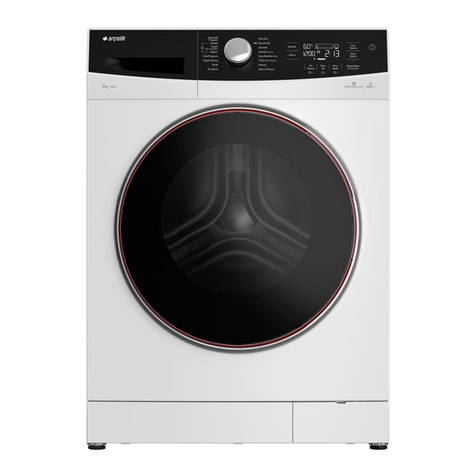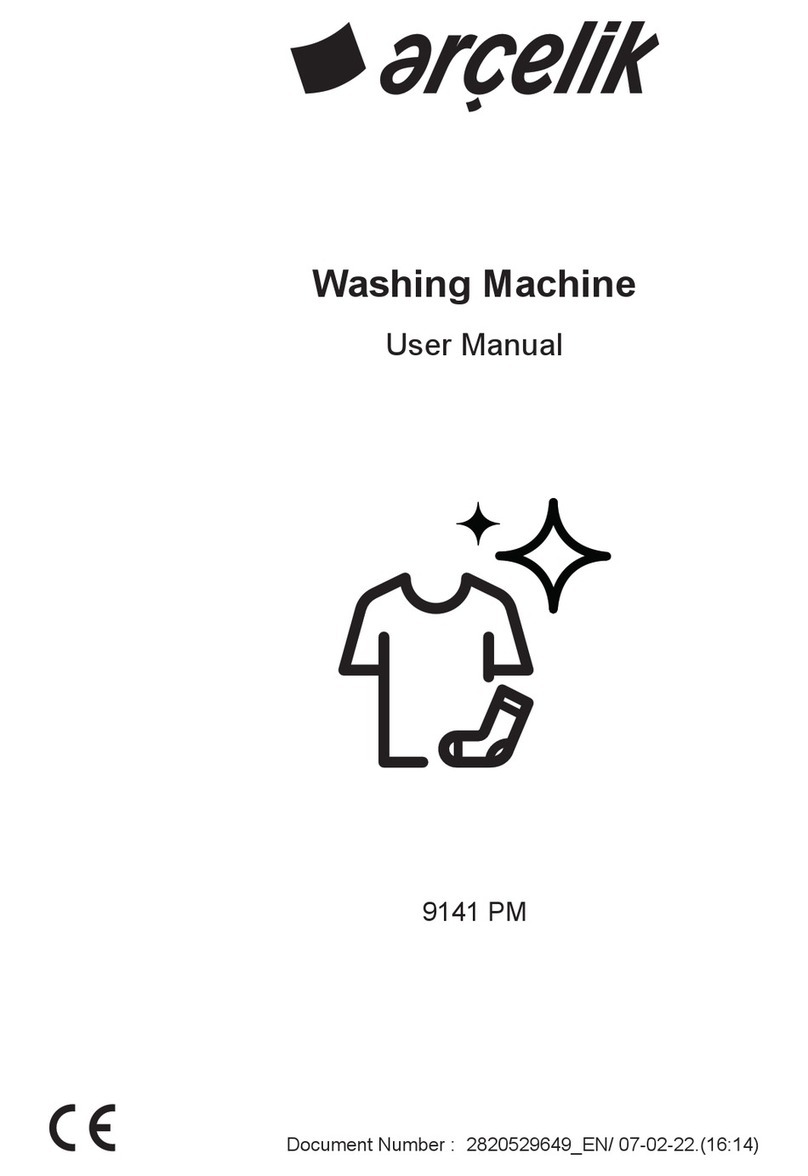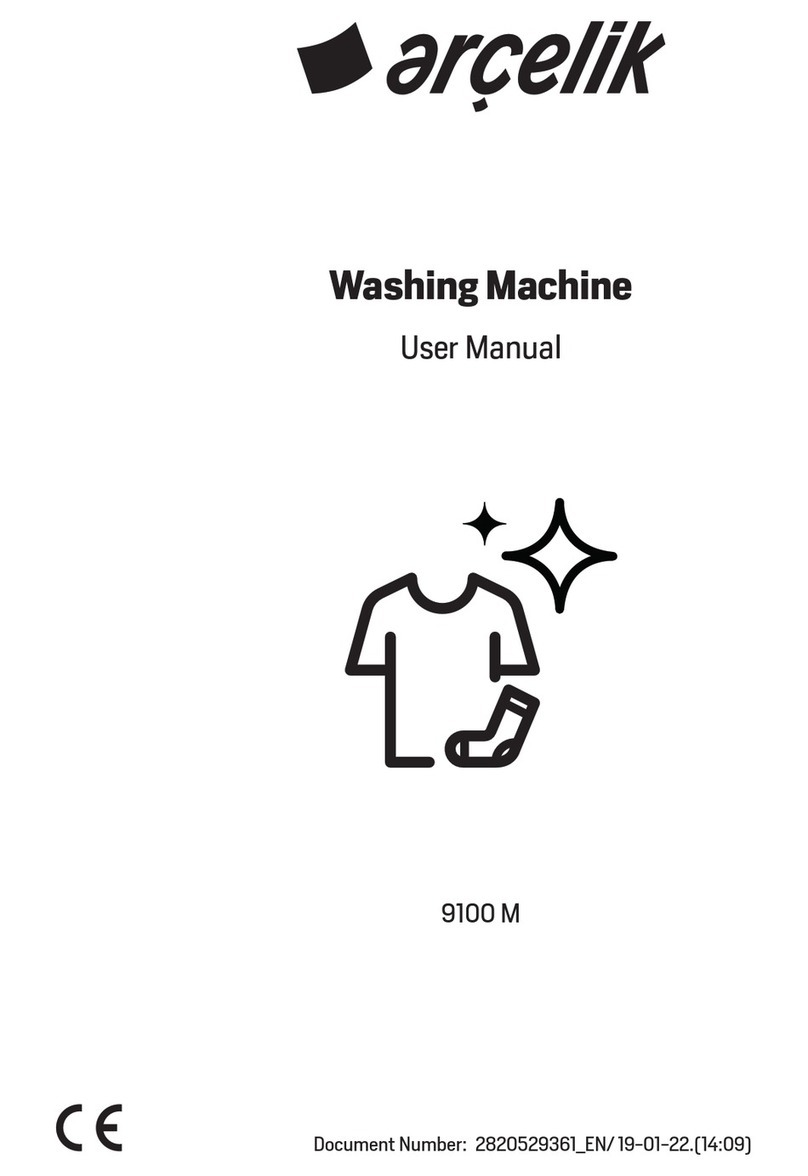arcelik BEKO RETRO User manual

RETRO WASHING MACHINE
SERVICE MANUAL NO:1
SERVICE MANUAL FOR
RETRO CONTROL SYSTEM
WASHING MACHINE

RETRO WASHING MACHINE
2
2. Contents
1. COVER 1
2. CONTENTS 2
3. SAFETY WARNINGS 5
3.1. GENERAL SAFETY ............................................................................................................................................................................. 5
3.2. INTENDED USE .................................................................................................................................................................................. 6
3.3. CHILDREN’S SAFETY .......................................................................................................................................................................... 6
3.4. COMPLIANCE WITH THE EEE DIRECTIVE ............................................................................................................................................. 6
3.5. PACKAGING INFORMATION .................................................................................................................................................................. 7
3.6. DISPOSING OF WASTE PRODUCT ........................................................................................................................................................ 7
3.7. POINTS TO BE CONSIDERED WHEN DELIVERING THE PRODUCT TO SERVICE .......................................................................................... 7
4. TECHNICAL SPECIFICATIONS ...................................................................................................................................... 9
4.1. PRODUCT DEFINITION....................................................................................................................................................................... 9
4.2. EXTERNAL DIMENSIONS ................................................................................................................................................................... 9
4.3. PACKAGING .................................................................................................................................................................................... 9
4.4. WEIGHT ......................................................................................................................................................................................... 9
4.5. GENERAL TECHNICAL VALUES .......................................................................................................................................................... 9
4.6. MAINS CABLE ................................................................................................................................................................................ 9
4.7. ENGINE .......................................................................................................................................................................................... 9
4.8. PUMP ............................................................................................................................................................................................. 9
4.9. WATER INLET .................................................................................................................................................................................. 9
4.10. BODY ............................................................................................................................................................................................. 10
4.11. DRUM ........................................................................................................................................................................................... 10
4.12. TUB ............................................................................................................................................................................................... 10
4.13. SUSPENSION SYSTEM ...................................................................................................................................................................... 10
4.14. CONTROL COMPONENTS .................................................................................................................................................................. 10
5. PRODUCT ASSEMBLY / INSTALLATION RULES / SETTINGS . . . . . . . . . . . . . . . . . . . . . . . . . . . . . . . . . . . . . . . . . . . . . . . . . . . . . . . . . . . . . . . . . . . . . . . . . . . . . . . . . . . . 11
5.1. PROPER LOCATION FOR INSTALLATION ............................................................................................................................................ 11
5.2. REMOVING THE PACKAGING REINFORCEMENTS.................................................................................................................................. 12
5.3. CONNECTING WATER SUPPLY .......................................................................................................................................................... 13
5.4. CONNECTING TO THE DRAIN ............................................................................................................................................................ 15
5.5. ADJUSTING THE FEET ...................................................................................................................................................................... 16
5.6. ELECTRICAL CONNECTING................................................................................................................................................................ 17
5.7. TRANSPORTATION OF THE PRODUCT ................................................................................................................................................ 18
6. USE OF PRODUCT AND BY-PRODUCTS ...................................................................................................................... 19
6.1. PREPARATION ................................................................................................................................................................................................................ 19
6.1.1. SORTING THE LAUNDRY ............................................................................................................................................................. 19
6.1.2. PREPARING LAUNDRY FOR WASHING .......................................................................................................................................... 20
6.1.3. THINGS TO BE DONE FOR ENERGY SAVING ................................................................................................................................. 21
6.1.4. CORRECT LOAD CAPACITY ......................................................................................................................................................... 21
6.1.5. LOADING THE LAUNDRY ............................................................................................................................................................. 22
6.1.6. USING DETERGENT AND SOFTENER ............................................................................................................................................ 22
6.1.7. FIRST USE ............................................................................................................................................................................... 25
6.1.8. TIPS FOR EFFICIENT WASHING ................................................................................................................................................... 26
6.2. CONTROL PANEL ............................................................................................................................................................................ 27
6.3. PREPARING THE MACHINE ............................................................................................................................................................... 28
6.4. PROGRAMME SELECTION ................................................................................................................................................................. 28
6.5. MAIN PROGRAMMES ........................................................................................................................................................................ 29
6.6. SPECIAL PROGRAMMES ................................................................................................................................................................... 30
6.7. WATER SUPPLY BUTTON (DEPENDS ON MODEL) ............................................................................................................................... 30
6.8. AIR TURBO BUTTON ........................................................................................................................................................................ 30
6.9. WATER LEVEL SELECTION ............................................................................................................................................................... 31
6.10. PROGRAMME AND CONSUMPTION TABLE ........................................................................................................................................... 32
6.11. TIME DISPLAY ................................................................................................................................................................................. 33
6.12. DELAY ........................................................................................................................................................................................... 33
6.13. STARTING THE PROGRAMME ............................................................................................................................................................ 34
6.14. CHANGING THE SELECTIONS AFTER PROGRAM HAS STARTED ............................................................................................................ 34
6.15. CHILD LOCK ................................................................................................................................................................................... 35
6.16. END OF PROGRAMME...................................................................................................................................................................... 36
6.17. FAVORITE PROGRAM SETTING ........................................................................................................................................................ 36
7. MAINTENANCE AND CLEANING .................................................................................................................................... 37
7.1. CLEANING THE DETERGENT DRAWER ............................................................................................................................................... 37
7.2. CLEANING THE FLUFF FILTER ........................................................................................................................................................... 38
7.3. CLEANING THE BODY AND CONTROL PANEL ...................................................................................................................................... 39
7.4. CLEANING THE WATER INTAKE FILTERS ............................................................................................................................................ 39
7.5. DRAINING REMAINING WATER AND CLEANING THE PUMP FILTER ......................................................................................................... 39
8. GENERAL OPERATION PRINCIPLE ............................................................................................................................... 42
8.1. WATER INTAKE PROFILE .................................................................................................................................................................. 42
8.2. BALANCED-UNBALANCED LOAD DETECTION ALGORITHM ..................................................................................................................... 43
9. COMPONENT OPERATION PRINCIPLES ....................................................................................................................... 45
9.1. ELECTRONIC CARD GROUP .............................................................................................................................................................. 45
9.2. WATER INTAKE VALVE ..................................................................................................................................................................... 45
9.3. SINGLE INTAKE VALVE ..................................................................................................................................................................... 45

RETRO WASHING MACHINE
3
9.6. WATER LEVEL SENSOR ................................................................................................................................................................... 46
9.7. SAFETY SWITCH ............................................................................................................................................................................. 46
9.8. MOTOR .......................................................................................................................................................................................... 47
9.9. CAPACITOR .................................................................................................................................................................................... 47
9.10. DRAIN PUMP .................................................................................................................................................................................. 48
9.11. TRACTION MOTOR........................................................................................................................................................................... 48
10. SERVICE FUNCTION TEST ........................................................................................................................................... 49
10.1. RECONFIGURATION OF UI MODEL (T1) ............................................................................................................................................ 49
10.2. DISPLAY ERROR CODES TEST (T2) .................................................................................................................................................. 50
10.3. SOFTWARE VERSION NUMBER TEST (T3) ......................................................................................................................................... 50
10.4. USER INTERFACE TEST (T4) ........................................................................................................................................................... 51
10.5. V1 COOL VALVE AND V2 SOFTENER VALVE TEST (T5) ...................................................................................................................... 51
10.6. VALVE 3 HOT VALVE TEST (T6) ....................................................................................................................................................... 51
10.7. TRACTION MOTOR TEST (T7) .......................................................................................................................................................... 52
10.8. PUMP TEST (T8) ............................................................................................................................................................................ 52
10.9. PRESSURE SENSOR TEST (Ta) ........................................................................................................................................................ 52
10.10. MOTOR TEST (Tb) .......................................................................................................................................................................... 52
10.11. RELIABILITY LIFE TIMES RECORDING (Tc) ....................................................................................................................................... 53
11. FAILURE/ERROR CODES ............................................................................................................................................... 54
12. FAILURE FLOW/TROUBLESHOOTING DIAGRAMS ..................................................................................................... 55
12.1. ELECTRONIC CARD SOCKETS ......................................................................................................................................................... 55
12.2. MACHINE DOES NOT START ........................................................................................................................................................... 56
12.3. ERROR CODES AND POSSIBLE CUSTOMER COMPLAINTS .................................................................................................................... 57
12.3.1. E1 ................................................................................................................................................................................... 58
12.3.2. E2 ................................................................................................................................................................................... 59
12.3.3. E3 ................................................................................................................................................................................... 60
12.3.4. E4 ................................................................................................................................................................................... 61
12.3.5. E5 ................................................................................................................................................................................... 62
12.3.6. E6 ................................................................................................................................................................................... 63
12.3.7. WATER INTAKE FROM WRONG COMPARTMENT ..................................................................................................................... 64
12.3.8. THE MACHINE IS BLOWING THE FUSE .................................................................................................................................. 65
13. ELECTRIC CIRCUIT / CONNECTION / E-CARD DIAGRAMS ....................................................................................... 66
14. COMPONENT INSTALLATION/REMOVAL ...................................................................................................................... 68
14.1. REAR PANEL INSTALLATION / REMOVAL .............................................................................................................................................. 68
14.1.1. INSTALLATION ........................................................................................................................................................................... 68
14.1.2. REMOVAL ................................................................................................................................................................................. 68
14.2. TOP COVER INSTALLATION / REMOVAL ............................................................................................................................................... 69
14.2.1. INSTALLATION ........................................................................................................................................................................... 69
14.2.2. REMOVAL ................................................................................................................................................................................. 69
14.3. LID GROUP INSTALLATION / REMOVAL ................................................................................................................................................ 70
14.3.1. INSTALLATION ........................................................................................................................................................................... 70
14.3.2. REMOVAL ................................................................................................................................................................................. 70
14.4. CONTROL BOARD INSTALLATION / REMOVAL ....................................................................................................................................... 71
14.4.1. INSTALLATION ........................................................................................................................................................................... 71
14.4.2. REMOVAL ................................................................................................................................................................................. 72
14.5. DETERGENT BOX INSTALLATION / REMOVAL ....................................................................................................................................... 73
14.5.1. INSTALLATION ........................................................................................................................................................................... 73
14.5.2. REMOVAL ................................................................................................................................................................................. 73
14.6. SINGLE VALVE INSTALLATION / REMOVAL ........................................................................................................................................... 74
14.7. DOUBLE-VALVE INSTALLATION / REMOVAL ........................................................................................................................................... 75
14.8. SAFETY SWITCH INSTALLATION / REMOVAL .......................................................................................................................................... 76
14.9. WATER SENSOR INSTALLATION / REMOVAL ........................................................................................................................................ 76
14.10. REAR COVER INSTALLATION / REMOVAL ............................................................................................................................................. 77
14.11. POWER CABLE INSTALLATION / REMOVAL ........................................................................................................................................... 77
14.12. CAPACITOR INSTALLATION / REMOVAL ................................................................................................................................................ 78
14.13. TUB COVER INSTALLATION / REMOVAL ............................................................................................................................................... 79
14.13.1. INSTALLATION ......................................................................................................................................................................... 79
14.13.2. REMOVAL ............................................................................................................................................................................... 79
14.14. DRUM GROUP INSTALLATION / REMOVAL ............................................................................................................................................ 80
14.14.1. INSTALLATION ......................................................................................................................................................................... 80
14.14.2. REMOVAL ............................................................................................................................................................................... 81
14.15. TUB GROUP INSTALLATION / REMOVAL ............................................................................................................................................... 82
14.15.1. INSTALLATION ......................................................................................................................................................................... 82
14.15.2. REMOVAL ............................................................................................................................................................................... 83
14.16. TRACTION MOTOR INSTALLATION / REMOVAL ...................................................................................................................................... 83
14.17. MOTOR BRACKET INSTALLATION / REMOVAL ....................................................................................................................................... 83
14.18. MOTOR CLUTCH GROUP INSTALLATION / REMOVAL .............................................................................................................................. 84
14.19. DRAIN PUMP INSTALLATION / REMOVAL .............................................................................................................................................. 84
15. EXPLOSION DRAWINGS .................................................................................................................................................. 85
15.1. TUB AND DRUM GROUP ................................................................................................................................................................... 85
15.2. CONTROL GROUP ............................................................................................................................................................................ 86
15.3. WATER SYSTEM GROUP .................................................................................................................................................................. 87
15.4. LID GROUP ...................................................................................................................................................................................... 88
15.5. BODY GROUP .................................................................................................................................................................................. 89
15.6. TOP COVER GROUP ......................................................................................................................................................................... 90

RETRO WASHING MACHINE
4
16. LIST OF COMPONENTS ................................................................................................................................................ 91
17. FIGURE AND PICTURE LIST ........................................................................................................................................ 92
18. TABLE LIST .................................................................................................................................................................... 94

RETRO WASHING MACHINE
5
3. Safety Warnings
This section contains safety instructions that will help protect from risk of personal injury or
property damage. Failure to follow these instructions shall void any warranty.
3.1 General safety
• This washing machine is not intended for use by persons (including children) with reduced
physical, sensory or mental capabilities or lack of experience and knowledge unless they
have been given supervision or instruction concerning the use of the washing machine by a
person responsible for their safety.
• Children should be supervised to ensure that they do not play with the washing machine.
• Never place the washing machine on a carpeted floor. Lack of airflow beneath the machine
could cause overheating.
• In case of a malfunction or maintenance work, disconnect the washing machine from the
electrical mains immediately. Repairs must only be made by a qualified technician.
• Before washing, check all clothes for loose buttons and tears. Check pockets for coins,
pins or other small articles. Close zips and fasteners. Ash small articles inside a pillow
case.
• Do not wash clothes stained with or soaked in petrol, thinners, kerosene, vegetable oil or
any other flammable liquids. Nor should any of these liquids be added to the wash water as
they constitute a fire hazard or there may be a risk of an explosion.
• Only use the machine for washing fabrics. Do not attempt to wash plastic leather or
fibreglass. Sort and separate clothes by fabric, color and degree of dirt.
• Use detergents, softeners and supplements suitable for top loading automatic washing
machines only.
• Always unplug the machine from the wall socket when it requires cleaning or service. Only
permit qualified persons to repair or install parts in the washer.
• Do not use water which is hotter than 60 degrees Celsius as this may deform plastic parts
of the machine. It could cause be in injury, electric shock or water leakage.
• The water supply and draining hoses must be securely fastened and remain undamaged to
prevent water leakage.
• By turning on the water before washing and ensure there is no water leakage.
• Follow the instructions on the textile tags and on the detergent package.
• Installation and repairing procedures must be carried out by an Authorized Service Agent.
Repairs carried out by incompetent persons create a user risk: There may be a risk of
accidental fire. If the washer operates abnormally, it may cause an injury. The
Manufacturer shall not be held liable for damages that may arise from procedures carried
out by unauthorized persons.
• Do not expose the machine to any type of flame or put cigarettes or any volatile substances
on the machine top. The machine may catch fire or the machine may be deformed due to
its large number of plastic components.
• Do not install the machine in a bathroom or very humid place.
• Doing so may cause a malfunction or result in a short circuit and there is a risk of an
electric shock.
• Never wash the machine by spreading or pouring water onto it! Avoid spraying water on to
the control panel and back of the machine. There is the risk of an electric shock, and it may
cause the machine to malfunction.
Table of contents
Other arcelik Washer manuals
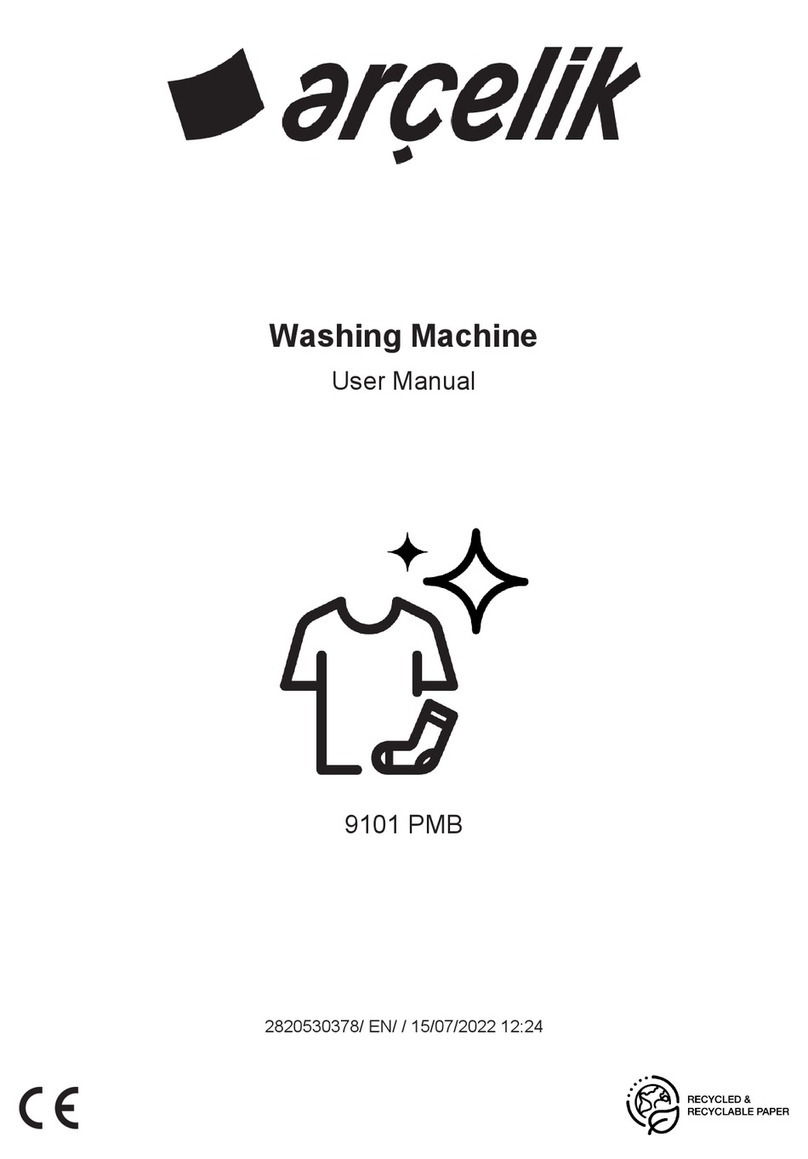
arcelik
arcelik 9101 PMB User manual
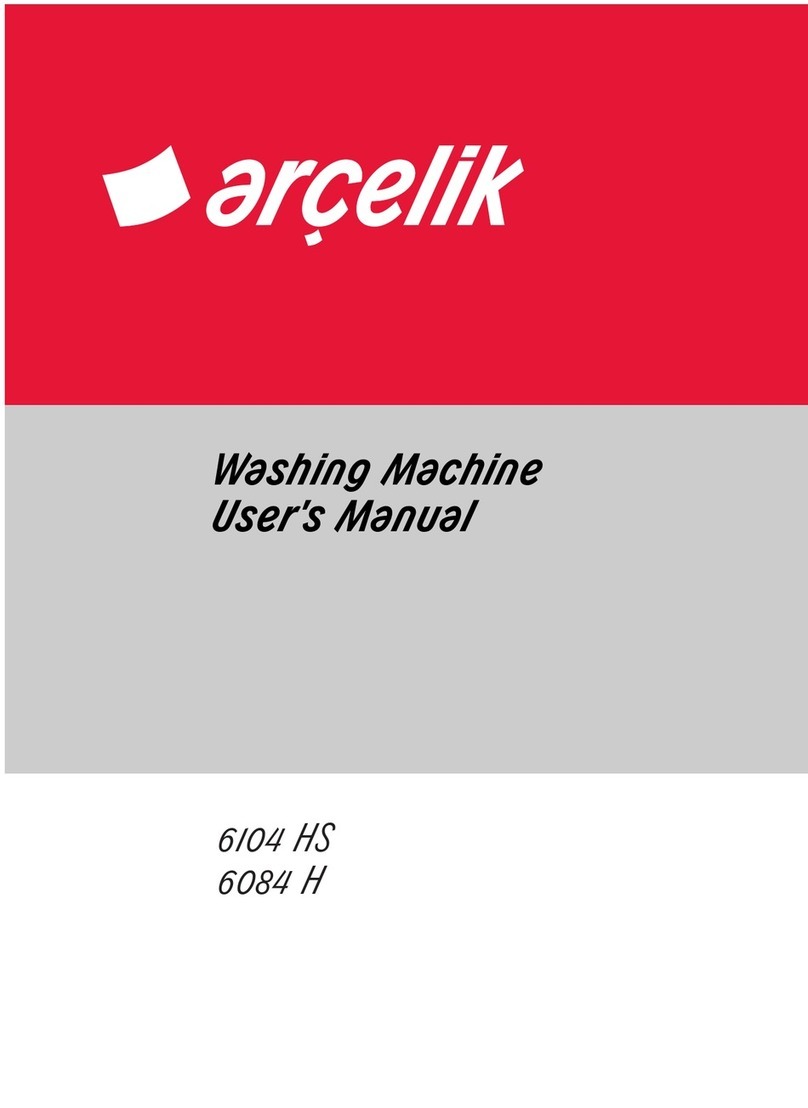
arcelik
arcelik 6104 HS User manual

arcelik
arcelik 9120 M User manual
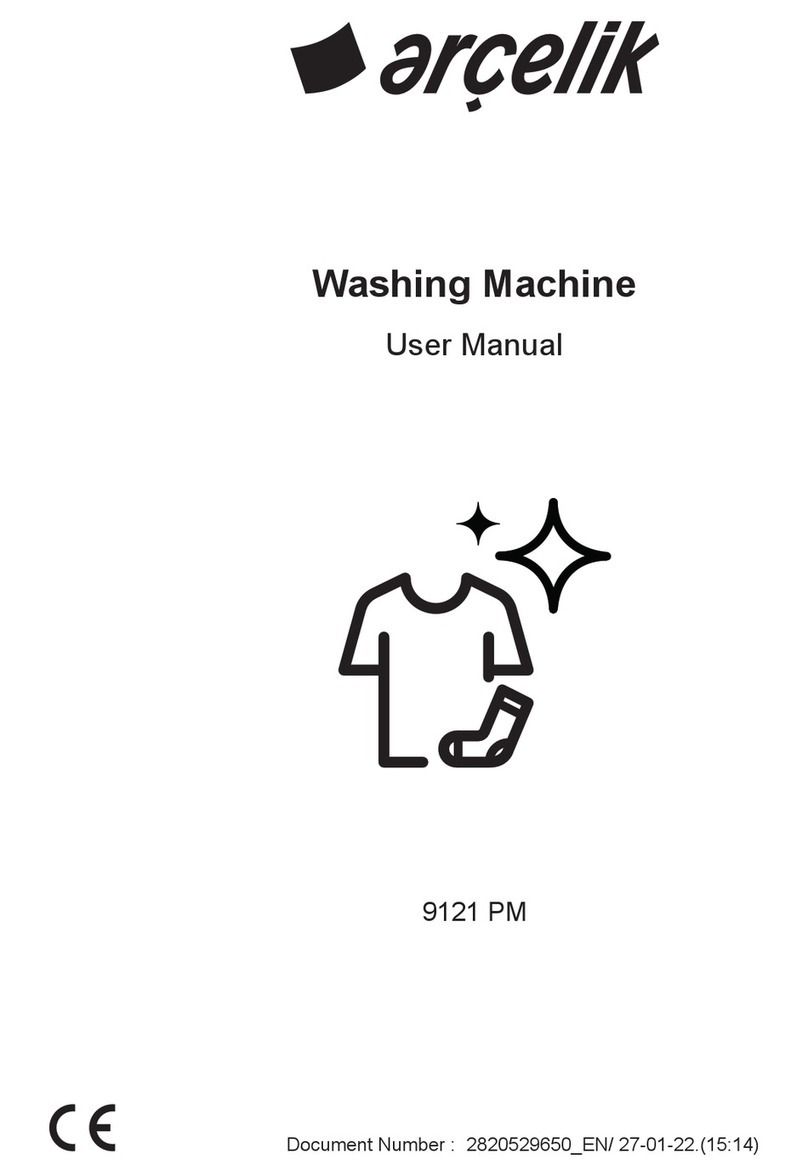
arcelik
arcelik 9121 PM User manual
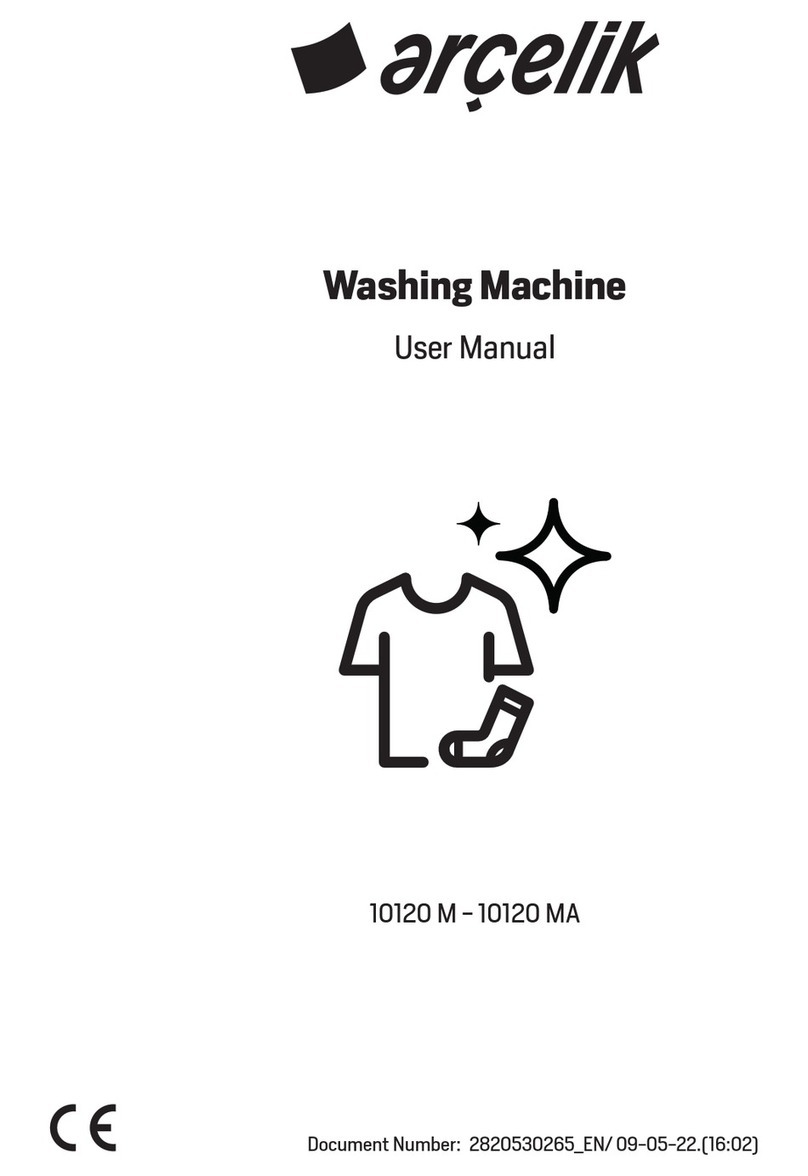
arcelik
arcelik 10120 M User manual
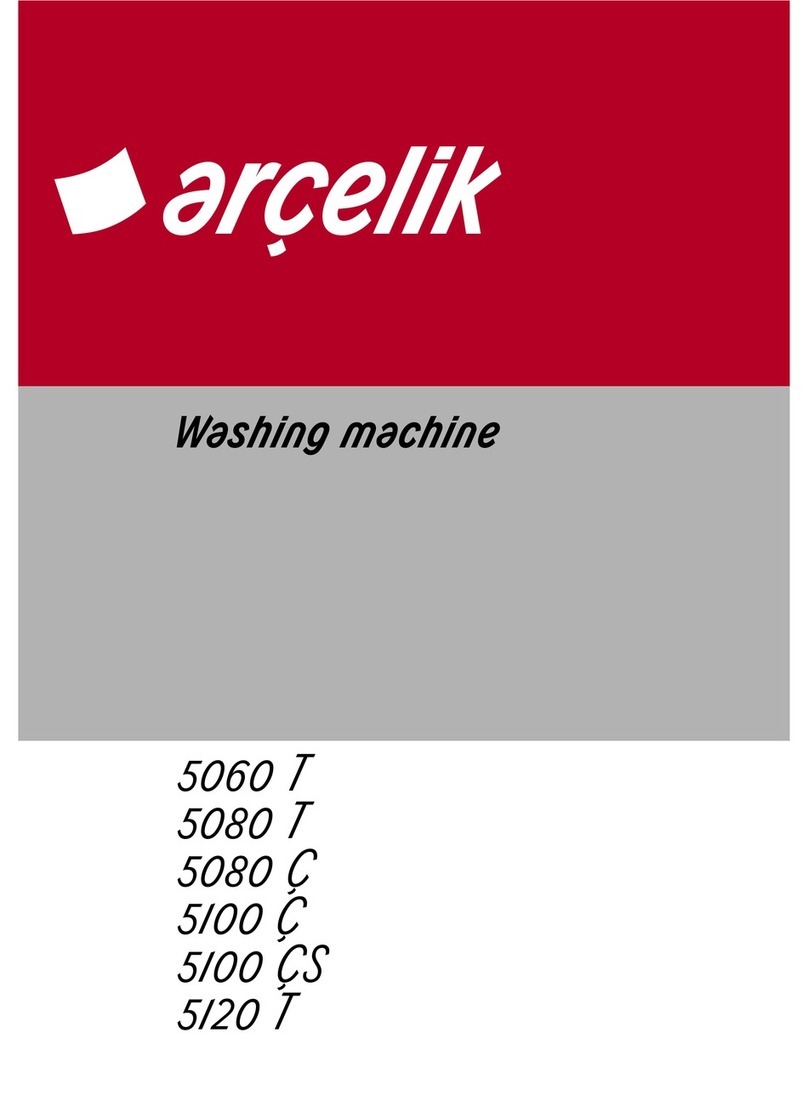
arcelik
arcelik 5060 T User manual
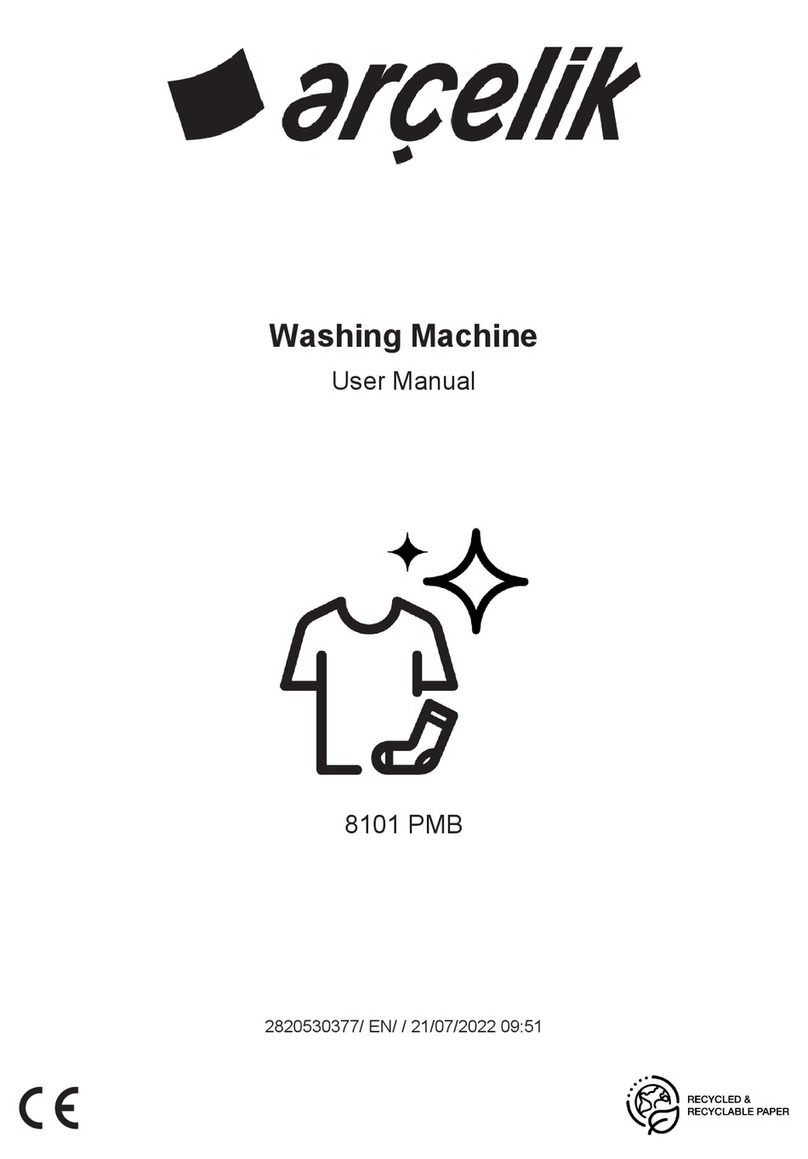
arcelik
arcelik 8101 PMB User manual
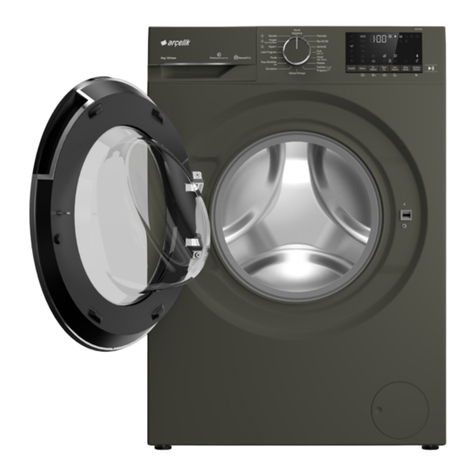
arcelik
arcelik 9102 PMG User manual

arcelik
arcelik 8104 HE User manual

arcelik
arcelik 9122 PM User manual

arcelik
arcelik 10121 PMB User manual
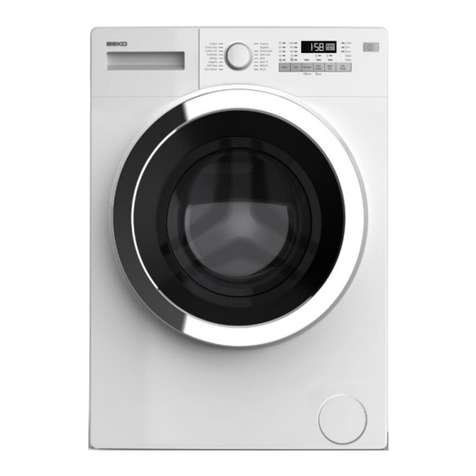
arcelik
arcelik beko B13 GOOD PLUS User manual

arcelik
arcelik 10124 D User manual
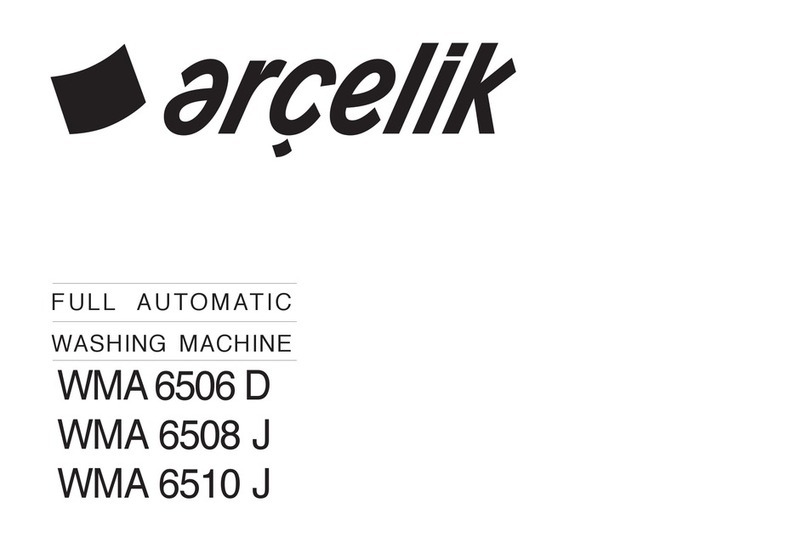
arcelik
arcelik WMA 6506 D User manual

arcelik
arcelik 5063 F User manual
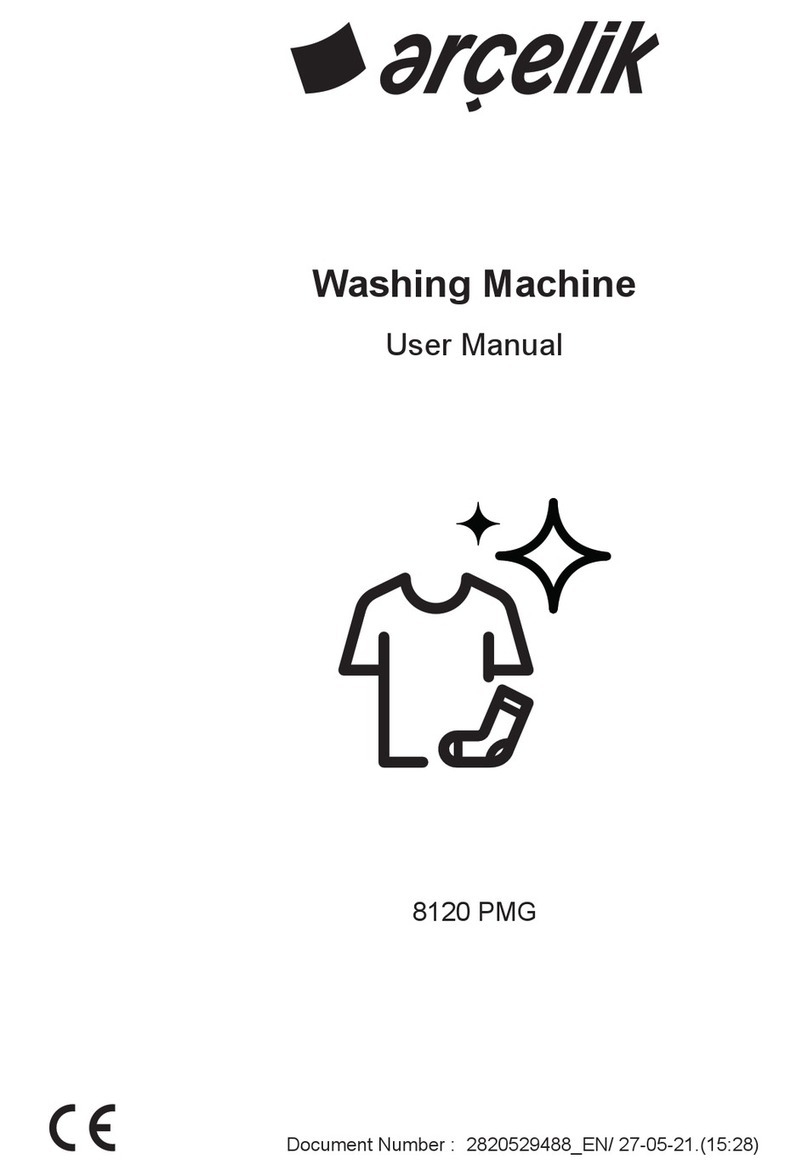
arcelik
arcelik 8120 PMG User manual
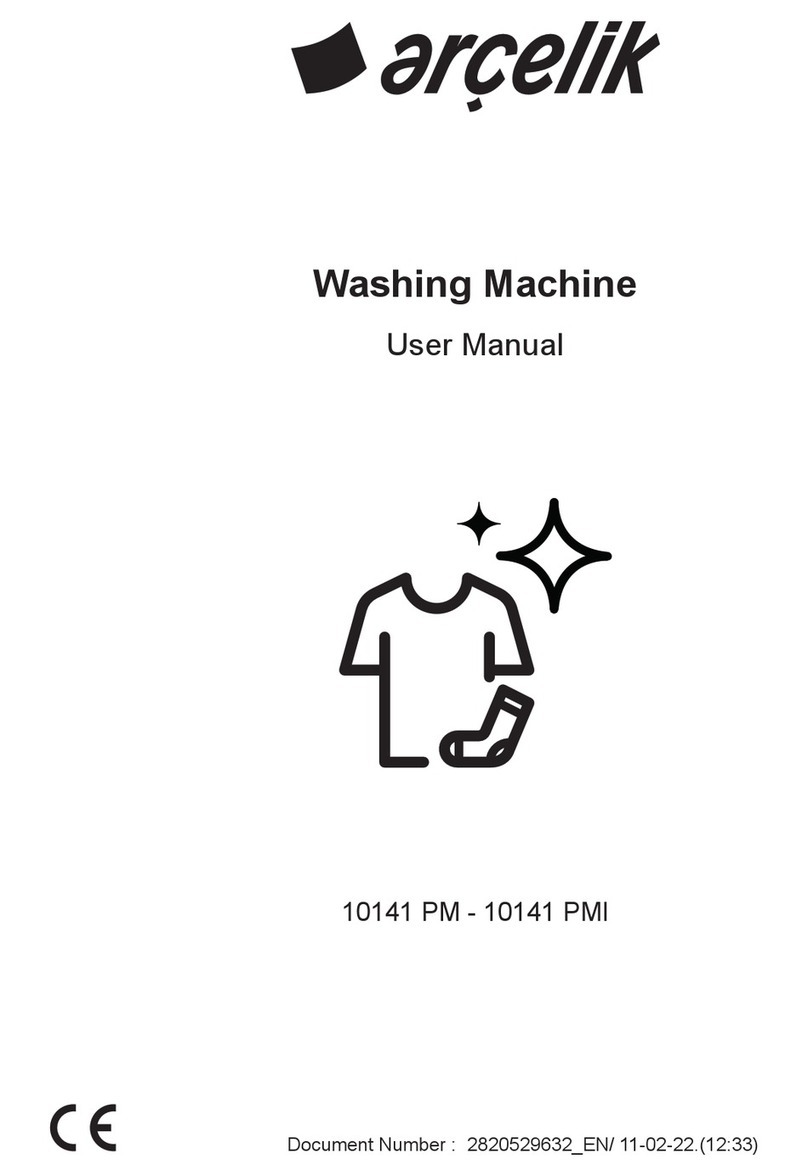
arcelik
arcelik 10141 PM User manual
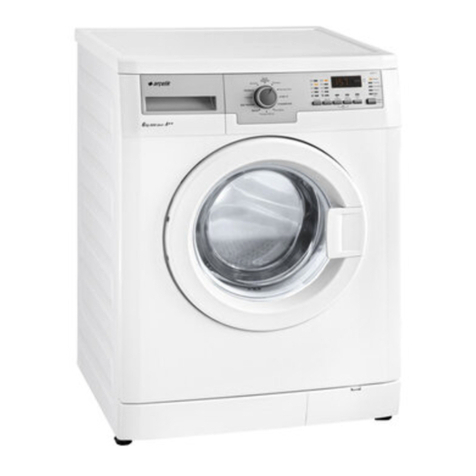
arcelik
arcelik 6083 H User manual
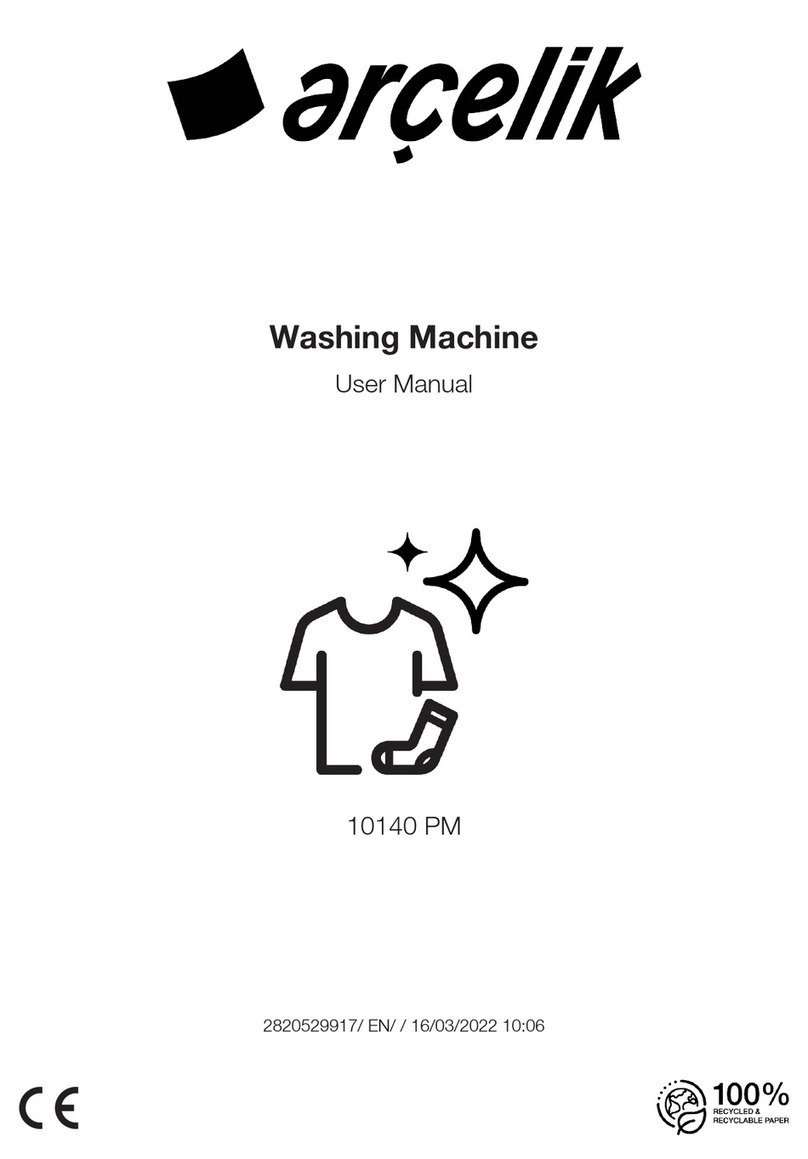
arcelik
arcelik 10140 PM User manual
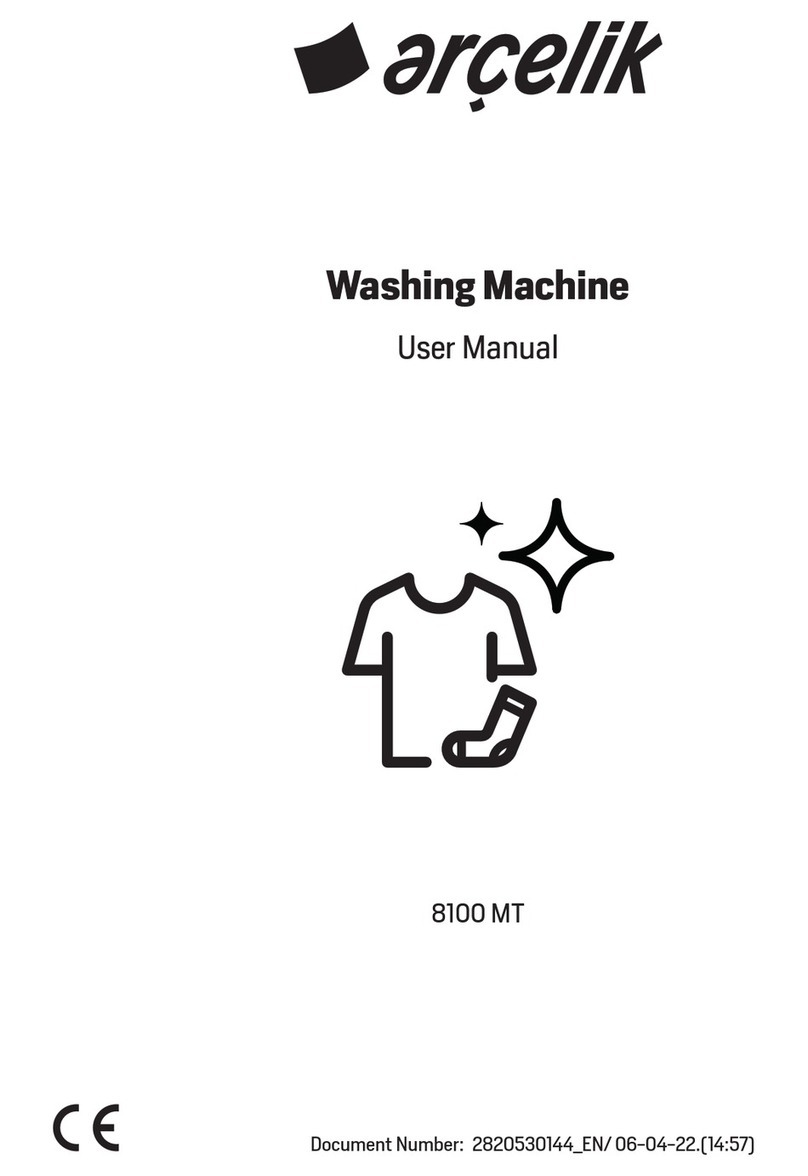
arcelik
arcelik 8100 MT User manual
